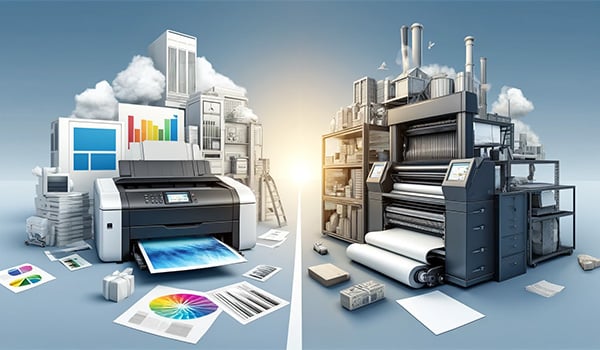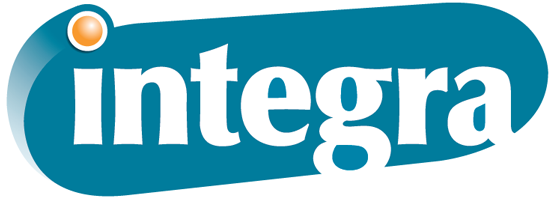What's the Difference Between Digital and Offset Printing?
April 5th, 2024 | 3 min read

Choosing the right printing method is a crucial step in bringing your project to life in the way you envision, efficiently and within your budget. At Integra Graphics Synergy, we aim to simplify this decision for you. Whether you're working on a marketing campaign, producing company reports or creating custom marketing materials, knowing the differences between digital and offset printing is key to the success of your print project.
We're here to clarify these options in plain language, focusing on what you need to know to make the best choice for your specific needs. By understanding the advantages and considerations of both digital and offset printing, you'll be able to select the method that not only meets your project's requirements but also fits your timeline and budget. Let's take a closer look at digital and offset printing, highlighting how each approach can benefit your paper-based printing projects and help you make an informed decision.
Our Favorite Analogy Explaining Offset vs. Digital Printing
At Integra, when we need to explain the difference between highly technical and complicated processes like offset and digital printing, we’re big fans of an easy-to-grasp analogy. You might think of us as print geeks for saying it, but a solid metaphor helps us explain these concepts quickly, and it allows our customers to wrap their heads around the function of each press type without needing to visit a print plant themselves.
So, without further ado, here goes our favorite for this particular topic:
Imagine you're deciding between taking a car or a freight train for a journey. Digital printing is like using a car. It's quick to start, flexible and perfect for shorter trips — or in printing terms, smaller print runs where speed and the ability to make last-minute changes are valuable. Offset printing, on the other hand, is akin to a freight train. It takes more effort and time to get moving, with initial setup processes like plate-making. However, once it's in motion, it's incredibly efficient and cost-effective for long hauls, making it ideal for large-scale print projects.
Digital Printing Explained: The Agile and Efficient Choice for Small Batches
In the realm of modern printing, digital technology stands out for its agility and efficiency. Ideal for small to medium volumes, digital printing eliminates the need for traditional plate-making, enabling a direct-from-file print process that significantly reduces setup times and costs. This immediacy not only caters to tight deadlines but also accommodates budget constraints, making it a preferred choice for projects requiring fewer than a few hundred to a thousand copies.
The key benefits of digital printing include:
- Flexibility and customization: Tailor your print runs easily with the ability to adjust and customize prints without significant additional costs.
- Cost-effectiveness for small runs: When you choose digital printing, you can avoid the setup costs associated with traditional printing methods, making digital a cost-efficient choice for smaller quantities.
- Speed to market: With minimal setup required, digital prints can be produced swiftly, ensuring your project reaches its audience without delay.
Is timeline a major factor in your print decisions? Get an estimate of how long your project might take with Integra by using our turnaround calculator below.
Offset Printing Explained: Mastering Large-Scale Efficiency
Offset printing, the time-honored stalwart of the print industry, remains unmatched for large-volume projects. The initial setup, involving the creation of plates for each color, is more labor-intensive and costly upfront. However, this method becomes significantly more cost-effective per unit as the print quantity increases, making it the go-to option for extensive runs that demand the highest quality.
The key benefits of offset printing include:
- Superior quality and precision: Offset printing delivers exceptional quality, with finer control over color and detail, especially for large runs.
- Economies of scale: The more you print, the lower the cost per piece, thanks to the efficiency of the offset process at scale.
- Material versatility: From unique paper types to custom finishes, offset printing offers broader capabilities to meet specific project requirements.
Navigating the Decision: Digital and Offset Printing Considerations
When deliberating between digital and offset printing, the choice boils down to your project's specific needs — quantity, quality, customization and budget. You'll also need to make sure your print professionals of choice have access to the type of press you'd consider most appropriate for your project.
Assessing Project Quantity: A Critical Factor
The number of copies required plays a pivotal role in choosing between digital and offset printing. For limited runs, digital printing offers a cost-effective and flexible solution. Conversely, offset printing becomes more economical for larger quantities, providing lower per-unit costs.
Quality and Customization: Meeting Your Project's Aesthetic Goals
Consider the level of quality and customization your project demands. While digital printing offers rapid production and flexibility, offset printing excels in delivering superior quality, especially for projects requiring precise color matching and customization.
Budget Considerations: Maximizing Value for Your Investment
Your budget is a crucial determinant. Digital printing minimizes upfront costs for small to medium projects, offering significant savings. Offset printing, requiring a higher initial investment, rewards larger projects with a cost advantage at scale.
Make Your Digital Printing vs. Offset Printing Choice With Confidence
In today's fast-paced print industry, making an informed decision between digital and offset printing sets the foundation for your project's success, which can feel stressful and overwhelming in the moment. Fortunately, you have options.
Equipped with the insights into digital and offset printing, you're now better positioned to choose the method that aligns with your project's scale, quality requirements and budgetary constraints. That said, if you'd still like someone else to handle the finer details and help you make the right choices, you can work with a reputable print broker who knows the industry front to back.
Ready to bring your print project to life? Reach out to Integra Graphics Synergy, a print broker near you. Our team of experts is dedicated to finding the perfect print solution for each customer's needs, ensuring each project's success from start to finish.
Topics:



